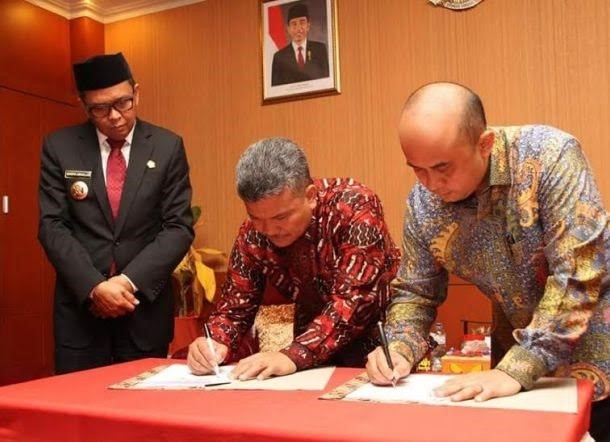Popular Reads
Top Results
Can't find what you're looking for?
View all search resultsPopular Reads
Top Results
Can't find what you're looking for?
View all search resultsChinese giant jumps into $980m power plant, LNG projects
Change text size
Gift Premium Articles
to Anyone
 Bajiminasa Bantaeng president director M. Taufik Fachtuddin (center) and Pasifik Agra Energi president director Westana H. Wiraatmadja (right) sign the memorandum of understanding (MoU) of the integrated LNG terminal mega-project while Bantaeng regent M. Nurdin Abdullah watches. (The Jakarta Post/Harri Rossa)
Bajiminasa Bantaeng president director M. Taufik Fachtuddin (center) and Pasifik Agra Energi president director Westana H. Wiraatmadja (right) sign the memorandum of understanding (MoU) of the integrated LNG terminal mega-project while Bantaeng regent M. Nurdin Abdullah watches. (The Jakarta Post/Harri Rossa)
L
ocal energy firm PT Energi Nusantara Merah Putih will team up with a Chinese engineering contractor to build a liquefied natural gas (LNG) receiving terminal and a combined-cycle power plant (PLTGU) in Bantaeng, South Sulawesi, with total investment value of US$980 million.
Sinland Development, a subsidiary of project engineering giant China Machinery Engineering Corporation (CMEC), is expected to develop the facilities under an engineering, procurement and construction contract.
The power plant, with a capacity of 600 megawatts (MW) of electricity, is deemed crucial to support the development of Bantaeng Industrial Park (KIBA), measuring about 3,000 hectares. Various smelters, especially for nickel, will be built within the industrial park in line with the government’s efforts to strengthen the country’s processing industry.
“The investment for these projects is huge. Hence, we need a guaranteed offtaker for the next 20 or 30 years. The collaboration with the CMEC will ensure demand from Chinese steel manufacturers in the long run, in addition to demand from nickel smelters in Bantaeng,” Energi Nusantara president director Westana H. Wiraatmadja said after signing a memorandum of understanding with CMEC in Jakarta on Friday.
The financial closures for the two facilities are expected to be reached by year-end, or February 2018 at the latest. Meanwhile, the commercial operations date is slated for the end of 2020 or beginning of 2021, as Energi Nusantara expects the construction will be completed within 36 months.
The power plant will need around 600,000 to 650,000 tons of LNG a year. However, Energi Nusantara has yet to decide whether it will import the LNG or buy it from a domestic supplier. “Indeed, the availability factor for gas is crucial for us to reach financial closure. Nonetheless, we still need more time to negotiate with the gas suppliers as it’s going to cost us big money, around $10 billion for a minimum 20 year-supply,” Westana said.
He estimated that the electricity price from the new plant would be around 9.8 US cents per kilowatt hour (kWh) if there was no significant jump in LNG prices.
According to the Upstream Oil and Gas Regulatory Special Task Force (SKKMigas), the weighted average price of LNG in the upstream sector was at $4.36 per million British thermal units (mmbtu) in 2016, with other costs including shipping, regasification and transmission reaching $4 to $6 per mmbtu.
At present, there are two nickel smelters in KIBA that plan to start operations before year-end. Moreover, the Bantaeng administration is currently negotiating with another investor to build a new smelter in the near future. Hence, the 600-MW PLTGU will play an important role in supporting the operation of smelters in KIBA, as currently there is only one hydroelectric power plant with a capacity of 4 MW in Bantaeng.
“The development of KIBA will increase the local economy in Bantaeng and its neighboring regions, as it will absorb [...] hundreds of workers and increase the land value around the industrial park,” said Bantaeng administration secretary Abdul Wahab.
(Read also: Mandatory low LNG price far from reality)
The Bantaeng administration has calculated that it can generate at least Rp 1 trillion (US$75 million) of income from KIBA when it is fully developed in the future. “Through the presence of a new power plant, for instance, we can get additional income from the street lighting tax,” said Abdul.
Meanwhile, CMEC chairman Sun Bai expected the collaboration with Energi Nusantara to pave the way for the company to undertake more infrastructure projects in Indonesia in the long run. “We will take a very aggressive step for the Indonesian market as it is a very important market for CMEC’s strategic plan,” Sun Bai said.









